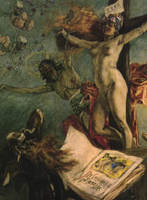In 1878 Rops wrote to his friend the painter François Taelemans:
"The subject is easy to understand; the good Saint Anthony, pursued by lustful visions, hastens to his prie-dieu, but at the same time, Satan - a peculiar red monk - plays a trick on him; he removes Christ from the cross and replaces Him with a beautiful girl, any self-respecting devil always has one handy. All of this is a mere pretext to paint a beautiful girl as nature intended her to be. A year ago she gave us eggs cooked with tripe to eat, according to the recipe of Touraine. Finally, after much insisting, she agreed to pose for her old Fély, in the same way as the Princess Borghèse posed for Canova. I changed only the hair..."
He continued:
"People should be aware that there is no question here of an attack on religion or of any eroticity. A beautiful girl, like the one you know, may be portraited (sic) without any idea of lechery. As for religion, it is not under attack. When Goya shows Lucifer stealing the Blessed Sacrament, he has no more anti-religious ideas than I...."
Rops was to write again with regard to this work:
"Here is more or less what I wanted Satan to say to the good Anthony (...) I want to show you that you are mad Anthony, to worship your abstractions! That your eyes may no longer search in the blue depths for the face of Christ, nor for incorporeal Virgins! Your Gods have followed those of Olympus (...) But Jupiter and Jesus did not carry off eternal Wisdom, nor Venus and Mary eternal Beauty! Even if the Gods are gone, Woman remains. The love of Woman remains and with it the abounding love of Life."
This famous work also captured the attention of Sigmund Freud:
"The engraver has chosen the model case of withdrawal into the life of saints and penitents. An ascetic monk takes refuge - probably to escape worldly temptations - near the image of the crucified Saviour. This cross fades like a shadow and in its place the radiant image of a naked woman in full bloom, takes its place, also in the shape of a crucifixion. Other painters, whose psychological insight was not as penetrating, positioned their analogous representations of temptation, with sin insolent and triumphant, somewhere alongside the Saviour on the Cross. Only Rops made it take the place of Our Lord Himself on the Cross; he seemed to know that the repressed thought returns at the very moment of its repression..."
